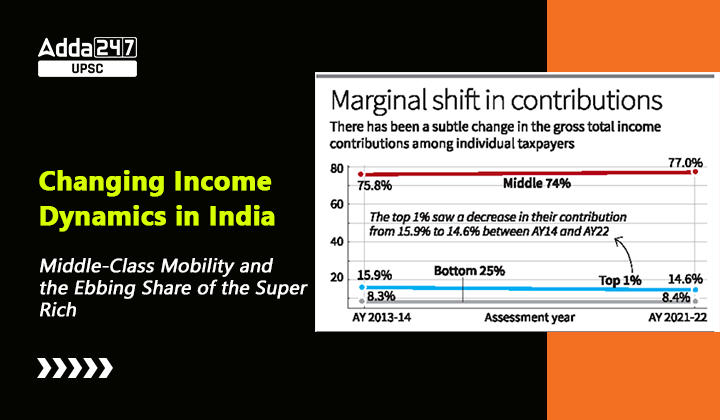Table of Contents
India’s economic landscape has been undergoing significant transformations over the past decade. The Central Board of Direct Taxes (CBDT) recently released data that shed light on these changes, indicating a widening tax base and a shift in income distribution. As the country grapples with discussions on income inequality, this data provides valuable insights. In this article, we will delve into the CBDT’s findings and their implications for India’s socio-economic fabric.
Widening Tax Base
- The CBDT’s report highlights a substantial increase in the number of income tax returns filed by individuals between the assessment years 2013-14 and 2021-22. The tax base has expanded significantly, revealing that more people are entering the formal income tax system.
- The Surge in Tax Filings
- In 2013-14, 3.36 crore individuals filed income tax returns.
- By 2021-22, this number had almost doubled, reaching 6.37 crore.
- This surge in tax filings can be attributed to various factors, including increased awareness of tax compliance, digitization, and economic growth.
Middle-Class Mobility
- The data shows that individuals are ascending the income ladder, demonstrating middle-class mobility. This is a positive sign for economic development and social upliftment.
- Expansion in the ₹5 lakh to ₹25 lakh Income Range
- Tax returns in the income range of ₹5 lakh to ₹10 lakh surged by 295% over the period.
- Similarly, for the ₹10 lakh to ₹25 lakh income range, there was a 291% increase in the number of returns filed.
Migration to Higher Income Groups
- The CBDT notes that individual taxpayers are displaying a trend of migrating to higher-income groups.
- This mobility suggests that economic opportunities and income growth are becoming accessible to a broader segment of the population.
Changing Income Distribution
While the CBDT data indicates a growing middle class and increased tax compliance, it also offers insights into the shifting landscape of income distribution.
Proportionate Contribution of the Super-Rich
- The proportionate contribution of gross total income by the top 1% of individual taxpayers has decreased from 15.9% to 14.6%.
- This suggests a moderation in the concentration of wealth among the super-rich.
- Rise of the Bottom 25% Taxpayers
- In contrast, the share of the bottom 25% of taxpayers increased from 8.3% to 8.4%.
- This signals a marginal improvement in the financial condition of the least affluent.
- Middle 74% Group Gains
The CBDT report reveals that the middle 74% group of individual taxpayers witnessed an increase in their proportionate share of gross total income, rising from 75.8% to 77%.
This is indicative of the middle class’s growing economic influence.
Income Growth Across Different Strata
The CBDT data also reflects the overall growth in income across different income groups, with implications for India’s economic progress and development.
Increase in Average Gross Total Income
The average gross total income for individual taxpayers increased from about ₹4.5 lakh to about ₹7 lakh over the nine-year period, representing an increase of 56%.
This demonstrates an improvement in the economic well-being of many taxpayers.
Differentiated Growth
Notably, the data shows that while the average gross total income for the top 1% of individual taxpayers increased by 42%, it grew by 58% for the bottom 25% of individual taxpayers.
This suggests that income growth has been relatively more pronounced at the lower end of the spectrum.
Implications and Significance
The CBDT’s findings hold significant implications for India’s economy, society, and policy-making. These implications can be seen from various angles:
Economic Mobility and Inclusivity
The increase in the number of tax filers and the migration to higher income groups reflect a more inclusive economy.
Economic mobility is a key driver of reducing income inequality and fostering social equity.
Tax Revenue and Government Finance
The expansion of the tax base has led to a substantial increase in net direct tax collections from ₹6.38 lakh crore in 2013-14 to ₹16.61 lakh crore in 2022-23.
This enhanced revenue collection can support government initiatives, including infrastructure development, social programs, and healthcare.
Policy Implications
- Policymakers should focus on creating an environment conducive to economic growth and opportunities for all income groups.
- Targeted policies can be devised to ensure that the benefits of economic growth are distributed more equitably.
Challenges Ahead
- While the data showcases positive trends, challenges such as unemployment, inflation, and access to quality education and healthcare persist.
- Addressing these challenges is crucial for sustained progress and broad-based prosperity.
Conclusion
The CBDT’s report provides a comprehensive overview of India’s changing income dynamics. It illustrates an expanding tax base, middle-class mobility, and a more inclusive income distribution. These trends are encouraging and signify progress towards a more equitable and prosperous society.
However, they also underscore the importance of continued efforts to address persistent socio-economic challenges. The data should serve as a foundation for informed policymaking that fosters sustainable and inclusive economic growth.



 TSPSC Group 1 Question Paper 2024, Downl...
TSPSC Group 1 Question Paper 2024, Downl...
 TSPSC Group 1 Answer key 2024 Out, Downl...
TSPSC Group 1 Answer key 2024 Out, Downl...
 UPSC Prelims 2024 Question Paper, Downlo...
UPSC Prelims 2024 Question Paper, Downlo...




